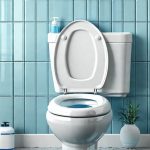The experience of flushing – seemingly mundane – can be surprisingly fraught for individuals grappling with obsessive-compulsive disorder (OCD), specifically those experiencing contamination fears or intrusive thoughts related to bodily fluids and waste. What begins as a necessary hygienic act can quickly morph into a cycle of compulsive checking, re-flushing, or excessive cleaning driven by anxiety. This isn’t about lacking basic hygiene; it’s about the mental struggle that arises when reassurance is sought through repeated actions, ultimately reinforcing the very anxieties they aim to quell. Understanding this dynamic and learning techniques for mindful engagement with flushing habits can be a significant step towards reclaiming control and diminishing the grip of OCD.
The core issue isn’t necessarily the act of flushing itself, but rather the interpretation placed upon it. Individuals may fear not being “clean enough,” worry about spreading germs, or experience intrusive thoughts suggesting contamination even after a perfectly normal flush. This leads to behaviors intended to neutralize these perceived threats – re-flushing until “just right,” avoiding public restrooms altogether, or spending excessive time washing hands and surfaces. These compulsive responses offer temporary relief but ultimately perpetuate the cycle of anxiety and reinforce the belief that these fears are valid. Flow desensitization, therefore, aims to gently challenge those beliefs by learning to tolerate the discomfort associated with letting go of control over the flushing process.
Understanding the OCD Cycle & Flushing Compulsions
The OCD cycle is a self-perpetuating loop consisting of obsessions (intrusive thoughts), anxiety, and compulsions (behaviors performed to reduce anxiety). In the context of flushing habits, this might look like: an intrusive thought about contamination arising after using the toilet, leading to intense anxiety and ultimately resulting in repeated flushing or cleaning. The temporary relief provided by these compulsions reinforces the belief that they are necessary for safety, even if logically they aren’t. This creates a vicious cycle where the more someone engages in compulsive behaviors, the stronger the OCD becomes. Breaking this cycle requires addressing not just the compulsion itself, but also the underlying anxieties and thought patterns, which may be helped by understanding how daily gentle motion habits for flow efficiency can improve overall well-being.
Many individuals with flushing-related compulsions report experiencing significant distress when attempting to resist these behaviors. They may feel overwhelmingly anxious, panicked, or even physically ill if they don’t re-flush or clean to a perceived acceptable standard. This is because OCD hijacks the brain’s reward system, associating compulsive actions with temporary relief and reinforcing them as coping mechanisms. It’s crucial to remember that this anxiety isn’t indicative of genuine danger; it’s a symptom of OCD. Acceptance and Commitment Therapy (ACT) principles often emphasize accepting these uncomfortable feelings rather than fighting against them, recognizing they will eventually pass even without compulsive behavior.
Mindful flushing habits are not about eliminating the intrusive thoughts entirely – that’s an unrealistic goal. Instead, they’re about changing your relationship to those thoughts and learning to respond differently. This involves acknowledging the thought without judgment, resisting the urge to engage in compulsions, and gradually exposing yourself to the discomfort of uncertainty. The process is akin to building a tolerance for distress, allowing you to navigate these anxieties with greater ease and confidence over time. Learning how to balance energy and stillness for flow can also be beneficial.
Implementing Mindful Flushing Techniques
Mindful flushing isn’t a quick fix; it’s a skill that requires practice and patience. Here are some techniques to begin incorporating into your routine:
- Delayed Flushing: Start by simply delaying the act of flushing for a few seconds after using the toilet. This introduces a small degree of uncertainty and challenges the immediate need for reassurance. Gradually increase the delay over time, working towards flushing at a less predictable moment. The goal isn’t to avoid flushing altogether, but to disrupt the automatic response and create space between thought and action.
- Single Flush Challenge: Commit to flushing only once, regardless of intrusive thoughts or anxiety levels. This can be incredibly challenging for those accustomed to repeated flushing, but it forces you to confront your fears directly. If anxious thoughts arise after a single flush, acknowledge them without engaging in compulsive behavior. Remind yourself that the fear is a symptom of OCD and doesn’t necessarily reflect reality.
- Observational Awareness: Pay attention to your physical sensations during the flushing process – the sound of the water, the feeling of release, any anxiety you experience. Observe these sensations without judgment, simply acknowledging their presence. This helps create distance between yourself and your thoughts, reducing their power over your behavior.
These techniques aren’t about suppressing your anxieties; they’re about learning to tolerate them. It’s perfectly normal to feel uncomfortable during this process, but remember that discomfort is a sign of progress. Consistency is key. Start small, be patient with yourself, and celebrate even the smallest victories. Considering post-flare self-care habits for flow recovery can also reinforce positive coping mechanisms.
Reframing Intrusive Thoughts & Fears
Intrusive thoughts are often characterized by vivid imagery and catastrophic predictions. For instance, someone might fear that failing to re-flush will contaminate their entire bathroom or endanger their family. Recognizing these thoughts as intrusions – unwanted mental events rather than accurate reflections of reality – is a crucial step in breaking the OCD cycle. Challenge the thought: “Is there any real evidence to support this catastrophic outcome?” Often, the answer is no.
Another helpful technique is cognitive restructuring. This involves identifying the underlying beliefs that fuel your compulsions and challenging their validity. For example, if you believe that “everything must be perfectly clean,” question where that belief comes from and whether it’s realistic or helpful. Perfectionism often plays a significant role in OCD, and learning to embrace imperfection can be liberating. Consider the probability of actual harm versus the distress caused by the thought itself.
Seeking Support & Professional Guidance
While mindful flushing techniques can be incredibly effective, they are often most successful when combined with professional support. A therapist specializing in OCD can provide personalized guidance, help you develop coping strategies, and address any underlying anxieties or traumas that may be contributing to your compulsions. Exposure and Response Prevention (ERP) is a widely recognized therapy for OCD that specifically targets compulsive behaviors by gradually exposing individuals to their fears while preventing them from engaging in associated rituals.
Don’t hesitate to reach out to loved ones for support as well. Sharing your struggles with trusted friends or family members can provide emotional comfort and encouragement. However, be mindful of avoiding reassurance-seeking behavior, which can inadvertently reinforce the OCD cycle. Instead, focus on explaining your experiences and seeking understanding rather than validation. Remember that you are not alone, and help is available if you need it. Building a strong support system and accessing professional guidance can significantly enhance your journey towards reclaiming control over your flushing habits and living a life less burdened by OCD. Furthermore, exploring mindful morning planning for full urination cycles could offer additional tools for managing these concerns.





















